8 nov 2018
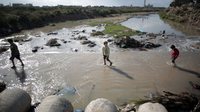
The unshaven doctor with circles under his eyes enters the children’s ward at Al Nassar Hospital in Gaza City. It’s a Thursday evening, almost the weekend. The ward is bleak and eerily quiet, but for the occasional wail of an infant.
At each cubicle, sectioned off by curtains, it’s a similar image: A baby lies alone in a bed, hooked up to tubes, wires and a generator; a mother sits in silent witness at the bedside.
Dr. Mohamad Abu Samia, the hospital’s director of paediatric medicine, exchanges a few quiet words with one mother, then gently lifts the infant’s gown, revealing a scar from heart surgery nearly half the length of her body.
At the next cubicle, he attends to a child suffering from severe malnutrition. She lies still, her tiny body connected to a respirator. Because electricity runs only four hours a day in Gaza, the baby must stay here, where generators keep her alive.
“We are very busy,” the overwhelmed doctor says. “Babies suffering from dehydration, from vomiting, from diarrhoea, from fever.” The skyrocketing rate of diarrhoea, the world’s second largest killer of children under five, is reason enough for alarm.
But in recent months Dr. Abu Samia has seen sharp rises in gastroenteritis, kidney disease, paediatric cancer, marasmus – a disease of severe malnutrition appearing in infants – and “blue baby syndrome”, an ailment causing bluish lips, face, and skin, and blood the colour of chocolate.
Before, the doctor says, he saw “one or two cases” of blue baby syndrome in five years. Now it’s the opposite – five cases in one year.
Asked if he has studies to back up his findings, he says: “We live in Gaza, in an emergency situation … We have time only to relieve the problem, not to research it.”
Yet Palestinian Ministry of Health figures support the doctor’s findings. They show a “doubling” of diarrheal disease, rising to epidemic levels, as well as spikes last summer in salmonella and even typhoid fever.
Independent, peer-reviewed medical journals have also documented increased infant mortality, anaemia, and an “alarming magnitude” of stunting among Gaza’s children.
A Rand Corporation study has found that bad water is a leading cause of child mortality in Gaza.
Simply put, Gaza’s children are facing a deadly health epidemic of unprecedented proportions.
“So much suffering,” says Dr. Abu Samia. It is, he says, a matter of “life and death”.
Multiple factors are to blame for the uncoiling health crisis, but medical experts agree on one central culprit: Gaza’s scarce and contaminated drinking water, owing to Israel’s economic siege, its repeated bombing of water and sewage infrastructure and a collapsing aquifer of such poor quality that 97 percent of Gaza’s drinking-water wells are below minimal health standards for human consumption.
Dr. Majdi Dhair, director of preventive medicine at the Palestinian Ministry of Health, reports a “huge increase” in waterborne disease, which he says a “directly related to drinking water” and to contamination from untreated sewage water flowing directly into the Mediterranean.
A visit to Gaza’s densely-packed Shati (or “Beach”) refugee camp helps explain why. There, 87,000 refugees and their families – expelled from their towns and villages during the creation of Israel in 1948 – are packed into half a square kilometre of cement-block structures along the Mediterranean.
“Water and electricity? Forget about it,” says Atef Nimnim, who lives with his mother, wife, and two younger generations – 19 Nimnims in all – in a small three-room dwelling in Shati.
The Gaza aquifer that sputters through their taps is far too salty, hardly anyone in Gaza drinks it any more. For drinking water, Atef’s 15-year-old son piles plastic jugs onto a wheelchair and rolls it to the mosque, where he fills the family’s containers, courtesy of Hamas.
Most families, even in the refugee camps, spend up to half their modest income on the desalinated water from Gaza’s unregulated wells. But even that sacrifice comes at a cost.
Faecal contamination
Palestinian Water Authority tests show that up to 70 percent of the desalinated water delivered by a small army of private trucks and stored in the camps’ rooftop tanks, is prone to faecal contamination.
Even microscopic amounts of E coli can bloom into a health crisis.
The reason for that, explains Gregor von Medeazza, UNICEF’s water and sanitation specialist for Gaza, is that the longer the E coli remain in the water, the more “they start growing” in the water and the worse it gets. This leads to chronic diarrhoea, which in turn can lead to stunting in Gaza’s children, as a British medical journal recently documented. One effect, von Medeazza says, is on “brain development,” and a “measurable effect on the IQ” of affected children.
High salinity and nitrate levels from Gaza’s collapsing aquifer – so badly overpumped that seawater is flowing in – are at the root of many of Gaza’s health problems. Elevated nitrate levels lead to hypertension and renal failure, and are linked to the rise in blue baby syndrome. Waterborne maladies like infant diarrhoea, salmonella and typhoid fever are caused by faecal contamination – both from the rooftop desalinated water and from the 110 million litres of raw and poorly-treated sewage that flows into the Mediterranean every day.
Because electricity here is shut off for 20 hours a day, Gaza’s sewage plant is essentially useless; hence, brown water spews into the sea, 24/7, from long pipes above a beach just north of Gaza City. Yet in the summertime, children continue to swim along Gaza’s beaches.
In 2016, five-year-old Mohammad Al-Sayis swallowed sewage-laced seawater, ingesting faecal bacteria that led to a fatal brain disease. Mohammad’s was the first known death by sewage in Gaza.
Making matters worse: Israeli rockets and shells damaged or destroyed Gaza water towers and pipelines, wells and sewage plants causing an estimated $34m in damages. This further crippled the delivery of safe, clean water, deepening the health catastrophe here. An even greater impact comes from Israel’s economic blockade, which Dr. Abu Samia blames directly on the area’s growing malnutrition.
The severe shortages of water and electricity, along with rising poverty, have damaged nutritional levels, Dr. Abu Samia says.
“It is affecting babies.”
Before the siege, he said, he had no patients suffering from malnutrition.
Now he frequently sees children with nutritional disease.
“We are seeing babies with marasmus” – a severe nutritional disease. “The last two years, it is increasing more and more.”
Gazans well remember the cynical words of Israeli minister Dov Weissglas in 2006, when he infamously compared the blockade to “a meeting with a dietician …We have to make them much thinner, but not enough to die.”
Gaza to become uninhabitable by 2020
Now, quite apart from the hundreds of deaths by rockets, missiles and bullets in the three most recent Gaza wars, children here are getting ill and dying from bad water and the infectious diseases that result.
“Occupation and siege are the primary impediments to the successful promotion of public health in the Gaza Strip,” declared a 2018 study in the Lancet, which cited “significant and deleterious effects to health care.”
Without a major intervention by the international community, and soon, humanitarian groups warn Gaza will become uninhabitable by 2020 – barely a year from now.
Failure to urgently intervene will result in “a huge collapse”, says Adnan Abu Hasna, Gaza spokesperson for UNRWA, the UN agency for Palestinian refugees, which recently had all its US funding cut by the Trump administration.
Otherwise, in less than two years, he says, “Gaza will not be a liveable place.”
And yet, liveable or not, the vast majority of Gaza’s two million people have nowhere else to go. Most are simply trying to live as normal lives as possible under extremely abnormal circumstances.
At dusk on a summer night, on a spit of rock and earth in the middle of Gaza harbour, five of those two million people try to enjoy a few minutes of quiet.
All around Ahmad and Rana Dilly and their three young children, the harbour ripples with life. Fishermen haul in their nets. Kids pose for selfies on broken concrete blocks and rebar – remnants of an old bombing raid.
Rana pours mango soda; Ahmad insists on handing out some chocolate wafers.
“You are with Palestinians,” he laughs, dismissing those who reject his offer.
Their three young children nibble on chips.
The Dillys have the same problems as many Gaza families.
Ahmad, a money changer, had to rebuild his shop in 2014 after an Israeli missile destroyed it.
Like most Gazans, the family has to contend with the salty water from the taps and the inherent risks of disease from the trucked water they rely on. But these problems mean little to them compared with their wish to feel safe and to enjoy fleeting moments of living like a normal family.
“I know the situation is horrible, but I just want to let my kids have a little change from time to time,” Ahmad says. “I want them to see something different. I want my family to feel safe.”
In the distance, an explosion echoes. Ahmad pauses for a short moment, then ignores it.
He says, “I come here to the sea, and forget about all the world.”
~ Al Jazeera/Days of Palestine
At each cubicle, sectioned off by curtains, it’s a similar image: A baby lies alone in a bed, hooked up to tubes, wires and a generator; a mother sits in silent witness at the bedside.
Dr. Mohamad Abu Samia, the hospital’s director of paediatric medicine, exchanges a few quiet words with one mother, then gently lifts the infant’s gown, revealing a scar from heart surgery nearly half the length of her body.
At the next cubicle, he attends to a child suffering from severe malnutrition. She lies still, her tiny body connected to a respirator. Because electricity runs only four hours a day in Gaza, the baby must stay here, where generators keep her alive.
“We are very busy,” the overwhelmed doctor says. “Babies suffering from dehydration, from vomiting, from diarrhoea, from fever.” The skyrocketing rate of diarrhoea, the world’s second largest killer of children under five, is reason enough for alarm.
But in recent months Dr. Abu Samia has seen sharp rises in gastroenteritis, kidney disease, paediatric cancer, marasmus – a disease of severe malnutrition appearing in infants – and “blue baby syndrome”, an ailment causing bluish lips, face, and skin, and blood the colour of chocolate.
Before, the doctor says, he saw “one or two cases” of blue baby syndrome in five years. Now it’s the opposite – five cases in one year.
Asked if he has studies to back up his findings, he says: “We live in Gaza, in an emergency situation … We have time only to relieve the problem, not to research it.”
Yet Palestinian Ministry of Health figures support the doctor’s findings. They show a “doubling” of diarrheal disease, rising to epidemic levels, as well as spikes last summer in salmonella and even typhoid fever.
Independent, peer-reviewed medical journals have also documented increased infant mortality, anaemia, and an “alarming magnitude” of stunting among Gaza’s children.
A Rand Corporation study has found that bad water is a leading cause of child mortality in Gaza.
Simply put, Gaza’s children are facing a deadly health epidemic of unprecedented proportions.
“So much suffering,” says Dr. Abu Samia. It is, he says, a matter of “life and death”.
Multiple factors are to blame for the uncoiling health crisis, but medical experts agree on one central culprit: Gaza’s scarce and contaminated drinking water, owing to Israel’s economic siege, its repeated bombing of water and sewage infrastructure and a collapsing aquifer of such poor quality that 97 percent of Gaza’s drinking-water wells are below minimal health standards for human consumption.
Dr. Majdi Dhair, director of preventive medicine at the Palestinian Ministry of Health, reports a “huge increase” in waterborne disease, which he says a “directly related to drinking water” and to contamination from untreated sewage water flowing directly into the Mediterranean.
A visit to Gaza’s densely-packed Shati (or “Beach”) refugee camp helps explain why. There, 87,000 refugees and their families – expelled from their towns and villages during the creation of Israel in 1948 – are packed into half a square kilometre of cement-block structures along the Mediterranean.
“Water and electricity? Forget about it,” says Atef Nimnim, who lives with his mother, wife, and two younger generations – 19 Nimnims in all – in a small three-room dwelling in Shati.
The Gaza aquifer that sputters through their taps is far too salty, hardly anyone in Gaza drinks it any more. For drinking water, Atef’s 15-year-old son piles plastic jugs onto a wheelchair and rolls it to the mosque, where he fills the family’s containers, courtesy of Hamas.
Most families, even in the refugee camps, spend up to half their modest income on the desalinated water from Gaza’s unregulated wells. But even that sacrifice comes at a cost.
Faecal contamination
Palestinian Water Authority tests show that up to 70 percent of the desalinated water delivered by a small army of private trucks and stored in the camps’ rooftop tanks, is prone to faecal contamination.
Even microscopic amounts of E coli can bloom into a health crisis.
The reason for that, explains Gregor von Medeazza, UNICEF’s water and sanitation specialist for Gaza, is that the longer the E coli remain in the water, the more “they start growing” in the water and the worse it gets. This leads to chronic diarrhoea, which in turn can lead to stunting in Gaza’s children, as a British medical journal recently documented. One effect, von Medeazza says, is on “brain development,” and a “measurable effect on the IQ” of affected children.
High salinity and nitrate levels from Gaza’s collapsing aquifer – so badly overpumped that seawater is flowing in – are at the root of many of Gaza’s health problems. Elevated nitrate levels lead to hypertension and renal failure, and are linked to the rise in blue baby syndrome. Waterborne maladies like infant diarrhoea, salmonella and typhoid fever are caused by faecal contamination – both from the rooftop desalinated water and from the 110 million litres of raw and poorly-treated sewage that flows into the Mediterranean every day.
Because electricity here is shut off for 20 hours a day, Gaza’s sewage plant is essentially useless; hence, brown water spews into the sea, 24/7, from long pipes above a beach just north of Gaza City. Yet in the summertime, children continue to swim along Gaza’s beaches.
In 2016, five-year-old Mohammad Al-Sayis swallowed sewage-laced seawater, ingesting faecal bacteria that led to a fatal brain disease. Mohammad’s was the first known death by sewage in Gaza.
Making matters worse: Israeli rockets and shells damaged or destroyed Gaza water towers and pipelines, wells and sewage plants causing an estimated $34m in damages. This further crippled the delivery of safe, clean water, deepening the health catastrophe here. An even greater impact comes from Israel’s economic blockade, which Dr. Abu Samia blames directly on the area’s growing malnutrition.
The severe shortages of water and electricity, along with rising poverty, have damaged nutritional levels, Dr. Abu Samia says.
“It is affecting babies.”
Before the siege, he said, he had no patients suffering from malnutrition.
Now he frequently sees children with nutritional disease.
“We are seeing babies with marasmus” – a severe nutritional disease. “The last two years, it is increasing more and more.”
Gazans well remember the cynical words of Israeli minister Dov Weissglas in 2006, when he infamously compared the blockade to “a meeting with a dietician …We have to make them much thinner, but not enough to die.”
Gaza to become uninhabitable by 2020
Now, quite apart from the hundreds of deaths by rockets, missiles and bullets in the three most recent Gaza wars, children here are getting ill and dying from bad water and the infectious diseases that result.
“Occupation and siege are the primary impediments to the successful promotion of public health in the Gaza Strip,” declared a 2018 study in the Lancet, which cited “significant and deleterious effects to health care.”
Without a major intervention by the international community, and soon, humanitarian groups warn Gaza will become uninhabitable by 2020 – barely a year from now.
Failure to urgently intervene will result in “a huge collapse”, says Adnan Abu Hasna, Gaza spokesperson for UNRWA, the UN agency for Palestinian refugees, which recently had all its US funding cut by the Trump administration.
Otherwise, in less than two years, he says, “Gaza will not be a liveable place.”
And yet, liveable or not, the vast majority of Gaza’s two million people have nowhere else to go. Most are simply trying to live as normal lives as possible under extremely abnormal circumstances.
At dusk on a summer night, on a spit of rock and earth in the middle of Gaza harbour, five of those two million people try to enjoy a few minutes of quiet.
All around Ahmad and Rana Dilly and their three young children, the harbour ripples with life. Fishermen haul in their nets. Kids pose for selfies on broken concrete blocks and rebar – remnants of an old bombing raid.
Rana pours mango soda; Ahmad insists on handing out some chocolate wafers.
“You are with Palestinians,” he laughs, dismissing those who reject his offer.
Their three young children nibble on chips.
The Dillys have the same problems as many Gaza families.
Ahmad, a money changer, had to rebuild his shop in 2014 after an Israeli missile destroyed it.
Like most Gazans, the family has to contend with the salty water from the taps and the inherent risks of disease from the trucked water they rely on. But these problems mean little to them compared with their wish to feel safe and to enjoy fleeting moments of living like a normal family.
“I know the situation is horrible, but I just want to let my kids have a little change from time to time,” Ahmad says. “I want them to see something different. I want my family to feel safe.”
In the distance, an explosion echoes. Ahmad pauses for a short moment, then ignores it.
He says, “I come here to the sea, and forget about all the world.”
~ Al Jazeera/Days of Palestine
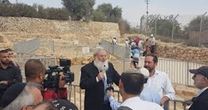
Dozens of Jewish settlers on Thursday stormed a Palestinian archeological site in al-Khalil, where they performed rituals under military protection.
A reporter for the Palestinian Information Center (PIC) said that dozens of settlers came from the settlements of Beit Hadassah, Beit Romano and Tel Rumeida and headed for an ancient site in Beersheba Street.
He added that Israeli troops escorted the settlers to protect them and closed several Palestinian commercial stores during their presence for about two hours at the site.
A reporter for the Palestinian Information Center (PIC) said that dozens of settlers came from the settlements of Beit Hadassah, Beit Romano and Tel Rumeida and headed for an ancient site in Beersheba Street.
He added that Israeli troops escorted the settlers to protect them and closed several Palestinian commercial stores during their presence for about two hours at the site.
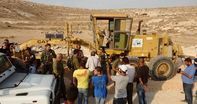
Israeli bulldozers leveled on Thursday morning Palestinian land lots located to the northeast of Akreba town, in the northern occupied West Bank.
Anti-settlement activist Yousef Diriyeh said Israeli vehicles rolled into Akreba, east of Nablus, and bulldozed large tracts of cultivated Palestinian land.
The occupation forces further leveled agricultural roads established east of Akreba to smooth farmers’ access to their lands, shortly after the local municipality finalized construction works.
Anti-settlement activist Yousef Diriyeh said Israeli vehicles rolled into Akreba, east of Nablus, and bulldozed large tracts of cultivated Palestinian land.
The occupation forces further leveled agricultural roads established east of Akreba to smooth farmers’ access to their lands, shortly after the local municipality finalized construction works.
7 nov 2018

Mustafa Abu Awda, 32
Egyptian military forces shot and killed a Palestinian fisherman off the coast of the southern Gaza Strip on Wednesday evening, the Ministry of Health in the besieged enclave said.
The Health Ministry said Mustafa Abu Awda, 32, was shot by Egyptian forces while at sea and died from his injuries.
It is unclear why Egyptian forces opened fire.
The incident comes as Palestinian fishermen already face daily risks in order to make a living, including routine harassment from Israeli naval forces, confiscation of boats and materials, detention, and potentially death.
Egyptian military forces shot and killed a Palestinian fisherman off the coast of the southern Gaza Strip on Wednesday evening, the Ministry of Health in the besieged enclave said.
The Health Ministry said Mustafa Abu Awda, 32, was shot by Egyptian forces while at sea and died from his injuries.
It is unclear why Egyptian forces opened fire.
The incident comes as Palestinian fishermen already face daily risks in order to make a living, including routine harassment from Israeli naval forces, confiscation of boats and materials, detention, and potentially death.

Dozens of Israeli soldiers accompanied many colonialist settlers’ buses into the northern West Bank city of Nablus, to visit a historic site, and invaded many neighborhoods in the city to remove the Palestinians from the streets, before clashing with dozens of youngsters, who hurled stones at them, while the soldiers fired live rounds, gas bombs, concussion grenades and rubber-coated steel bullets, wounding at least twenty Palestinians.
Media sources in Nablus said many army jeeps invaded Amman Street, and the areas surrounding Joseph’s Tomb, east of the city, and attacked dozens of protesters, wounding at least twenty.
The invasion was carried out by approximately 1000 settlers, in many buses, and dozens of soldiers in armored army vehicles.
They added that the soldiers fired a barrage of gas and concussion grenades at the protesters in addition to a number of homes and shops, causing fire in a shop for selling spare parts for vehicles.
The head of the Palestinian Red Crescent Society (PRCS) in Nablus, Ahmad Jibreel, said a young man suffered a fracture in the arm, while another young man was shot with live rounds in his leg, before the two were rushed to Rafidia Hospital.
He added that several Palestinians were shot with rubber-coated steel bullets, and fourteen others suffered the effects of teargas inhalation, and received the needed treatment by PRCS medics.
In related news, the soldiers stopped an ambulance transporting an elderly woman to a hospital, in the eastern part of Nablus, and forced the ambulance to turn around and look for alternate, longer roads.
Furthermore, the soldiers invaded the Dahia area in Nablus city, and Kafr Qalil town, east of the city, before invading the home of Yasser Afeef Amer, and searched the property, in addition to occupying its rooftop to use it as a monitoring post.
The army also abducted a young man, identified as Ahmad Anan Mansour, 19, from his home in the city, after invading and reaching it.
The Patriarch Joseph is revered by Jews, Muslims, Christians and Samaritans, but Israel only allows Jews into the shrine, as they believe the tomb to be his final resting place.
Palestinians generally hold that the tomb is the funerary monument to Sheikh Yousef Dweikat, a local religious and social figure.
Media sources in Nablus said many army jeeps invaded Amman Street, and the areas surrounding Joseph’s Tomb, east of the city, and attacked dozens of protesters, wounding at least twenty.
The invasion was carried out by approximately 1000 settlers, in many buses, and dozens of soldiers in armored army vehicles.
They added that the soldiers fired a barrage of gas and concussion grenades at the protesters in addition to a number of homes and shops, causing fire in a shop for selling spare parts for vehicles.
The head of the Palestinian Red Crescent Society (PRCS) in Nablus, Ahmad Jibreel, said a young man suffered a fracture in the arm, while another young man was shot with live rounds in his leg, before the two were rushed to Rafidia Hospital.
He added that several Palestinians were shot with rubber-coated steel bullets, and fourteen others suffered the effects of teargas inhalation, and received the needed treatment by PRCS medics.
In related news, the soldiers stopped an ambulance transporting an elderly woman to a hospital, in the eastern part of Nablus, and forced the ambulance to turn around and look for alternate, longer roads.
Furthermore, the soldiers invaded the Dahia area in Nablus city, and Kafr Qalil town, east of the city, before invading the home of Yasser Afeef Amer, and searched the property, in addition to occupying its rooftop to use it as a monitoring post.
The army also abducted a young man, identified as Ahmad Anan Mansour, 19, from his home in the city, after invading and reaching it.
The Patriarch Joseph is revered by Jews, Muslims, Christians and Samaritans, but Israel only allows Jews into the shrine, as they believe the tomb to be his final resting place.
Palestinians generally hold that the tomb is the funerary monument to Sheikh Yousef Dweikat, a local religious and social figure.
6 nov 2018

The Israeli military threatened on Tuesday to uproot dozens of olive trees planted on Palestinian land in the village of Bardala, in the northern Jordan Valley.
Local activist Aref Daraghmeh said the targeted olive trees date back to over 15 years and are located close to civilian homes.
Daraghmeh said the measure makes part of Israeli attempts to rein in Palestinians’ presence in the area, destabilize farmers’ agricultural activity, and seize Palestinian lands in favor of illegal settlement expansion.
Local activist Aref Daraghmeh said the targeted olive trees date back to over 15 years and are located close to civilian homes.
Daraghmeh said the measure makes part of Israeli attempts to rein in Palestinians’ presence in the area, destabilize farmers’ agricultural activity, and seize Palestinian lands in favor of illegal settlement expansion.

The Israeli occupation forces (IOF) on Monday dismantled several structures belonging to a Palestinian citizen in the Jordan Valley, east of the West Bank, claiming they were unlicensed.
Local activist Aref Daraghmeh told Quds Press that Israeli forces stormed al-Hadidiya area in the Jordan Valley and embarked on dismantling eight structures used for residential and agricultural purposes before confiscating them.
Those structures were given to Omar Bishara, a local resident, as humanitarian assistance after the Israeli army removed a home and other facilities belonging to him last month.
Local activist Aref Daraghmeh told Quds Press that Israeli forces stormed al-Hadidiya area in the Jordan Valley and embarked on dismantling eight structures used for residential and agricultural purposes before confiscating them.
Those structures were given to Omar Bishara, a local resident, as humanitarian assistance after the Israeli army removed a home and other facilities belonging to him last month.

MP Jamal al-Khudari, the head of the Popular Committee Against the Siege, on Monday said that Israel has banned the entry of about 200 kinds of goods needed by the industrial and commercial sectors into the Gaza Strip.
Al-Khudari said in press statements that lifting the ban on these items is a key requirement to revive Gaza's economy which is gravely affected by the 12-year-long blockade.
He noted that raw materials, which are much needed for the industry, are among the items banned from entering the Gaza Strip via Karam Abu Salem crossing, the only Gaza crossing that is partially open.
The significant decline in the production process has adversely affected the economy and led to unprecedentedly high rates of poverty and unemployment, he added.
Al-Khudari said that about 85% of Gaza factories are closed either partially or completely, pointing out that the industrial and commercial sectors have so far suffered a $50-million loss.
The Palestinian MP stressed that any solution aimed at reviving Gaza's economy and creating job opportunities should include full opening of Gaza crossings and free import and export of goods without Israeli restrictions.
Given the presence of over 250,000 jobless Palestinians in the Gaza Strip, he said, the enclave needs at least $25 million a month to start emergency projects that would provide jobs for about 50,000 workers as a first stage of economic recovery.
Al-Khudari said in press statements that lifting the ban on these items is a key requirement to revive Gaza's economy which is gravely affected by the 12-year-long blockade.
He noted that raw materials, which are much needed for the industry, are among the items banned from entering the Gaza Strip via Karam Abu Salem crossing, the only Gaza crossing that is partially open.
The significant decline in the production process has adversely affected the economy and led to unprecedentedly high rates of poverty and unemployment, he added.
Al-Khudari said that about 85% of Gaza factories are closed either partially or completely, pointing out that the industrial and commercial sectors have so far suffered a $50-million loss.
The Palestinian MP stressed that any solution aimed at reviving Gaza's economy and creating job opportunities should include full opening of Gaza crossings and free import and export of goods without Israeli restrictions.
Given the presence of over 250,000 jobless Palestinians in the Gaza Strip, he said, the enclave needs at least $25 million a month to start emergency projects that would provide jobs for about 50,000 workers as a first stage of economic recovery.
4 nov 2018
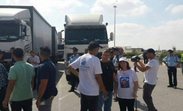
Local Hebrew sources reported, according to Al Ray, that dozens of Israeli settlers, on Sunday morning, crossed the road to Karem Abu Salem trade crossing, blocking Palestinian traffic. video
Channel 7 said that a terrible traffic jam developed, as a result of Israeli demonstrators gathering in protest of the deteriorating security situation, in order to force Israeli government to change the condition.
In addition, some 150 Israeli students from the Gaza region also plan to protest security instability; the demonstration is set to start from the borders to occupied Jerusalem.
A cabinet meeting is being held today, to make a decision on funds coming into the Gaza Strip, with the start of a two-day truce.
Channel 7 said that a terrible traffic jam developed, as a result of Israeli demonstrators gathering in protest of the deteriorating security situation, in order to force Israeli government to change the condition.
In addition, some 150 Israeli students from the Gaza region also plan to protest security instability; the demonstration is set to start from the borders to occupied Jerusalem.
A cabinet meeting is being held today, to make a decision on funds coming into the Gaza Strip, with the start of a two-day truce.
3 nov 2018
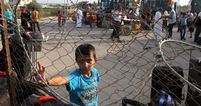
A Qatari popular campaign has raised more than $4 million for the Palestinian people in Gaza within 26 days, Qatar’s official television declared Friday.
On October 7, #GazaDeservesLife campaign was launched with the aim of making contribution towards the development of Gaza Strip, and alleviating the suffering of its people.
The campaign is supervised by the Regulatory Authority for Charitable Activities. Qatar Red Crescent, Qatar Charity, Education Above All, and the Silatech Foundation are participating in the campaign.
The campaign aims to raise QR10m to cover the urgent needs of the Palestinian people in Gaza in five main fields. Those five fields are health, education, social welfare, water, and economic empowerment.
The campaign reflects the support of the people of Qatar and their commitment towards fulfilling the humanitarian needs of the people in Gaza, especially in times of need.
It also reflects the integration of Qatar’s official and popular roles in carrying out their humanitarian duties, both in terms of urgent relief assistance in times of disasters and crises and in the implementation of sustainable development projects that promote the chances of peace and stability and fight poverty.
On October 7, #GazaDeservesLife campaign was launched with the aim of making contribution towards the development of Gaza Strip, and alleviating the suffering of its people.
The campaign is supervised by the Regulatory Authority for Charitable Activities. Qatar Red Crescent, Qatar Charity, Education Above All, and the Silatech Foundation are participating in the campaign.
The campaign aims to raise QR10m to cover the urgent needs of the Palestinian people in Gaza in five main fields. Those five fields are health, education, social welfare, water, and economic empowerment.
The campaign reflects the support of the people of Qatar and their commitment towards fulfilling the humanitarian needs of the people in Gaza, especially in times of need.
It also reflects the integration of Qatar’s official and popular roles in carrying out their humanitarian duties, both in terms of urgent relief assistance in times of disasters and crises and in the implementation of sustainable development projects that promote the chances of peace and stability and fight poverty.
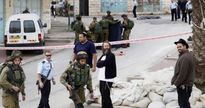
Dozens of Jewish settlers from the illegal settlement of Kiryat Arba attacked last night and on Saturday morning Palestinian citizens and homes in the Old City of al-Khalil.
A reporter for the Palestinian Information Center (PIC) said that a horde of extrimist settlers attacked, for the second consecutive day, homes and families in as-Salayma neighborhood near the Ibrahimi Mosque.
He affirmed that several members of Palestinian families in this neighborhood suffered injuries during the settlers’ attack. Some of the wounded citizens were identified as Samiha as-Salayma, Hasan Abd Rabo, Khalil as-Salayma, Mohamed Da’na, Khalil Da’na, and Saber as-Salayma.
Israeli soldiers also helped the settlers in their attack and fired volleys of tear gas grenades on homes and closed several businesses.
Soldiers also stormed the house of Samih Da’na in Da’na neighborhood near the settlement of Kiryat Arba, occupied its rooftop where they deployed a tent, and set up a checkpoint at the entrance to the house, and embarked on searching passersby and checking their IDs.
Earlier, soldiers from the units of Golani and Givati escorting a horde of Kiryat Arba settlers attacked last night Ghaith neighborhood in the Old City of al-Khalil. The attack was described as the most violent in two years.
According to eyewitnesses, the soldiers physically assaulted Palestinian young men as they were sitting with their kids outside their homes in Ghaith neighborhood, causing fractures and bruises to five of them.
During that attack, the Israeli occupation forces cordoned off the neighborhoods of as-Salayma and Ghaith to secure the withdrawal of settlers.
A reporter for the Palestinian Information Center (PIC) said that a horde of extrimist settlers attacked, for the second consecutive day, homes and families in as-Salayma neighborhood near the Ibrahimi Mosque.
He affirmed that several members of Palestinian families in this neighborhood suffered injuries during the settlers’ attack. Some of the wounded citizens were identified as Samiha as-Salayma, Hasan Abd Rabo, Khalil as-Salayma, Mohamed Da’na, Khalil Da’na, and Saber as-Salayma.
Israeli soldiers also helped the settlers in their attack and fired volleys of tear gas grenades on homes and closed several businesses.
Soldiers also stormed the house of Samih Da’na in Da’na neighborhood near the settlement of Kiryat Arba, occupied its rooftop where they deployed a tent, and set up a checkpoint at the entrance to the house, and embarked on searching passersby and checking their IDs.
Earlier, soldiers from the units of Golani and Givati escorting a horde of Kiryat Arba settlers attacked last night Ghaith neighborhood in the Old City of al-Khalil. The attack was described as the most violent in two years.
According to eyewitnesses, the soldiers physically assaulted Palestinian young men as they were sitting with their kids outside their homes in Ghaith neighborhood, causing fractures and bruises to five of them.
During that attack, the Israeli occupation forces cordoned off the neighborhoods of as-Salayma and Ghaith to secure the withdrawal of settlers.
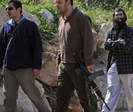
A number of extremist illegal Israeli colonialist settlers attacked, on Friday evening, two Palestinians in the Salaima neighborhood in Hebron city, in the southern part of the occupied West Bank.
Eyewitnesses said the assailants attacked the two Palestinians in their neighborhood, near the Ibrahimi Mosque, causing various cuts and bruises.
They added that the colonists also attacked several shops in the same area before Israeli soldiers invaded it, and forced all Palestinian shops to close, in addition to firing concussion grenades and gas bombs at many residents.
A local Palestinian, identified as Sameeh Da’na, said the soldiers invaded his home, and installed a tent on its rooftop to use it as a monitoring tower.
The soldiers also installed several roadblocks, in addition to increasing their deployment in the neighborhoods of the Old City.
Eyewitnesses said the assailants attacked the two Palestinians in their neighborhood, near the Ibrahimi Mosque, causing various cuts and bruises.
They added that the colonists also attacked several shops in the same area before Israeli soldiers invaded it, and forced all Palestinian shops to close, in addition to firing concussion grenades and gas bombs at many residents.
A local Palestinian, identified as Sameeh Da’na, said the soldiers invaded his home, and installed a tent on its rooftop to use it as a monitoring tower.
The soldiers also installed several roadblocks, in addition to increasing their deployment in the neighborhoods of the Old City.
2 nov 2018

Palestinian farmers in Salfit villages and towns have complained that Israeli settlements, especially Ariel settlement, keep polluting their olive groves with wastewater.
Farmers told a reporter for the Palestinian Information Center (PIC) that Ariel, the second largest settlement in the occupied West Bank, was pouring sewage into the valleys of Salfit city and the towns of Hares, Kifl Hares, Bruqin and Kafr ad-Dik as well as the tourist areas of Wad al-Mutawi and Wad al-Fawwar.
The sewage coming from this settlement, in particular, is polluting the soil in those areas, especially through getting mixed with either rainwater or spring water in Wad al-Mutawi.
The settlement of Ariel has been pumping its sewage directly into nearby Palestinian areas for years, creating a dangerous and unhealthy situation for local residents and contaminating groundwater and crops.
Farmers told a reporter for the Palestinian Information Center (PIC) that Ariel, the second largest settlement in the occupied West Bank, was pouring sewage into the valleys of Salfit city and the towns of Hares, Kifl Hares, Bruqin and Kafr ad-Dik as well as the tourist areas of Wad al-Mutawi and Wad al-Fawwar.
The sewage coming from this settlement, in particular, is polluting the soil in those areas, especially through getting mixed with either rainwater or spring water in Wad al-Mutawi.
The settlement of Ariel has been pumping its sewage directly into nearby Palestinian areas for years, creating a dangerous and unhealthy situation for local residents and contaminating groundwater and crops.

The Israeli municipality in Occupied Jerusalem on Thursday morning imposed financial penalties on Palestinian storeowners in Shu’fat refugee camp, northeast of the holy city.
According to Quds Press, an Israeli municipal crew escorted by police forces stormed Shu’fat camp and embarked on fining owners of businesses at the pretext that the signs placed outside their stores were not licensed.
The municipal crew also fined owners of Palestinian cars parked on the streets of the camp and confiscated quantities of water bottles from outside a store.
According to Quds Press, an Israeli municipal crew escorted by police forces stormed Shu’fat camp and embarked on fining owners of businesses at the pretext that the signs placed outside their stores were not licensed.
The municipal crew also fined owners of Palestinian cars parked on the streets of the camp and confiscated quantities of water bottles from outside a store.
Page: 39 - 38 - 37 - 36 - 35 - 34 - 33 - 32 - 31 - 30 - 29 - 28 - 27 - 26 - 25 - 24 - 23 - 22 - 21 - 20 - 19 - 18
